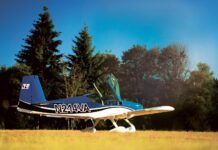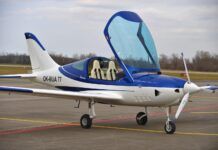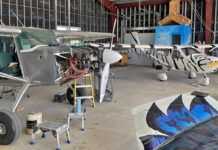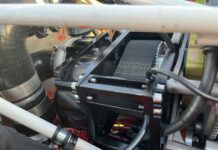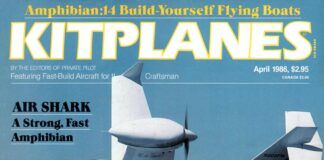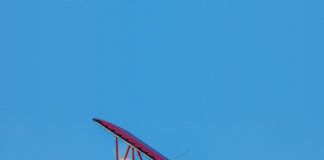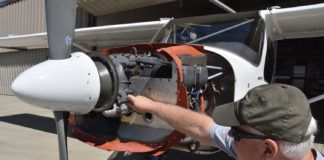Momentum. If we were robots, we could smoothly pick up where we left off last month. But as you know if you’ve ever taken on a multi-month project, no small amount of energy and time is spent scratching your head and wondering where to start or restart.
That seems to be the secret in getting this sort of job done: Be out there every day, or at least don’t put it aside for a week or two. Many years ago I heard of a guy who built an RV-6 in something like 32 days. More astonishing was that it was a slow-build kit; he had to drive all 14,000 rivets. If I remember correctly, he put a bed and refrigerator in the hangar, closed the door to prevent interruption, and had his wife delivering meals. That this one was the third or fourth RV that he’d built helped him keep to the dictum of not laying hands on a part more than once. No inventorying. Out of the box, drill, deburr, primer, rivet, repeat. But then sometimes you have to back up. And back up. And back up. And I don’t mean your hard drive.
Last month I had put the fuselage on the maingear and was feeling pretty good about it. Neighbors dropped by and made “Wow!” comments, and all was right with the world. Then I tried to install the trim cable. The slot in the tail that serves as its exit point had been cut to size, but I cut to the inside of the fat, felt-tip pen line supplied by Jabiru. That made it about an eighth of an inch too narrow. The solution was to fit a round file onto a 24-inch-long tube and then go from the inside to enlarge the slot. Had I simply thought it through, I would have tried to poke the cable through the slot before attaching the ventral fin.
I was feeling smug about having found a solution, never realizing that the other shoe was about to drop. There’s only one correct position for the horizontal part of the tail, which, consequently, controls the position of the elevator. The elevator, in turn, has its control lever fixed in place at the factory. Therefore, there’s only one correct position for the elevator control horn. Jabiru supplied a line, and I put the horn on the wrong side of it.
As I sat there staring at this, my thoughts drifted off to the movies. The Three Stooges are building a house. Curly, the bald Stooge, keeps throwing nails over his shoulder with his usual guttural squeal of frustration. Moe, the one who was always doing the slapping, comes over with, “Say, what do you think you’re doing?”
“These nails! They’ve got the head on the wrong end!” says Curly.
“You moron! Those are for the other wall!” says Moe with the inevitable dope-slap.
It was one of those days where I wasn’t sure if I was Curly, Moe or the nail!
The only solution was to roll over the entire airplane and cut off the horn. But to do that I had to cut off the ventral fin that I’d installed.
I don’t want to leave you with the wrong impression here. About eight months after this debacle, I received a third set of instructions from Jabiru that had been totally revised and were relatively clear in this area. Today’s builders can tackle this task with some assurance that they won’t have to repeat my missteps.
Still, I would recommend that you not install the ventral fin or the horn until after the elevator is installed and the cables are through the slot. Alignment of the horn is a lot easier with all the bits available. Yes, the fin and horn are easier to install with the airplane upside down, but a dab of Super Glue will suffice for achieving the perfect positioning, followed by several layers of glass for strength.
The Other End of the Elevator Control Cable
Actually, it’s not a cable. It’s a push-pull rod similar to that used for most aircraft throttles, and it’s identical to those used between the helm (steering wheel to you landlubbers) and the engine of most towable boats. It’s used for the ailerons as well, with the advantage being that installation requires no pulleys. The disadvantage is that the length has to be just right.
And it was. There are four cables and they’re nicely labeled: elevator, trim, aileron, aileron. The process of threading the aft end of the elevator and trim cables through the now-enlarged slots required that they be fed all the way from the forward connection point at the center console.
So there it hung, waiting for something to which it would be connected. Again, kudos to Jabiru. The manual really does leave you feeling that you’ve made progress every day, because the next step was to fit the control stick, and the project was less than a month old.
Jabiru aircraft have the control stick mounted on the center console. It pivots fore and aft on an aluminum fitting, actuating the pitch cable above the pivot, which is in turn connected to an aluminum tube that extends back behind the front seats. The twisting motion of the control tube is picked up behind to actuate the ailerons through two cables.
Two large plastic grommets have to be epoxied in place to hold both ends of the main tube in position relative to the center console. These grommets prevent fore-aft motion of the tube while still allowing rotation. It is vital for smooth operation of the controls that the grommets be perfectly aligned, and the only way to do it is to have the grommets on the tube when applying the epoxy. Message? Apply a bit of grease to the tube where it passes through the grommets; you don’t want epoxy on aluminum. Once the epoxy has hardened, the grease can be cleaned off of the extracted tube. Neglecting this will result in a situation about as welcome as a meadow muffin on the dinner table.
Paint…Already?
This moves really, really fast, but it seems ridiculous. Paint the interior? At first this seems way too soon, but in hindsight it’s a good idea. Yes, I know I described some of this in the last installment of this series. I want to emphasize here that it’s essential that you read the instructions and then step back to understand what is being asked of you. Painting the interior seems a straightforward task. But what you’re doing is painting the areas that will be exposed after the upholstery is installed, so there’s no need to apply paint to, say, the seat pans. And you definitely don’t want to be spraying with the windows installed. There are seven windows, so doing this painting now will save you a lot of masking and taping later.
Jabiru recommends a spatter-type of paint, and it does create a nice effect. It’s a three-step process: a color base coat followed by a texture coat, and then protected with a hard clear-coat. Three sets of cans, purchased from your local hardware store, should be plenty. After nine months of dropping tools on it, I can attest to the durability, and the spatter aspect disguises the exposed surfaces so you don’t have to spend weeks of sanding only to have one or two surface-finish flaws stand out like a prairie dog hole on the White House lawn.
Stick ’Em Up
The epoxy finally hardened around the control stick bushings. Jabiru’s Jim McCormick says this is a 6-hour process, but I see it more like 24 hours, mixed as he said to. It must be the cooler mountain air where I live. The aileron control stop bracket will not fit as the fixture decrees it should. The lower fuselage spine has about 0.100 inch of interference to the bottom of the bracket. Should I raise the bracket? Or cut the lower edge of the bracket? Or cut the spine area of the fuselage? The bracket has adjustable stops, so I thought I’d raise the bracket and back down on the stops. That way the worst-case scenario does not have any component weakened.
After all that cogitation I abandoned this system altogether. My buddy Ron pulled the covers off his linkage and showed me what he’d done. Per Jabiru, the control cables are to be routed through the wingroots, through the upper sides of the fuselage and then arc down behind your head to the aft end of that control tube. I never liked this because it puts the cable in the way of anyone reaching over the seats, and, if you’re tall enough, it’s possible that the cable will touch the back of your head. Ron changed the routing to go inside the wingstrut, down to the lower side of the fuselage where a small hole allows it to gracefully arc up to the same point on the control tube.
It’s not quite that simple because you’ll have to make a new component on that milling machine you bought. Whereas before the cables had come down to the left and right of the control tube and then attached to the bracket with two bolts, now they come to a point below the tube and attach with a single bolt. If you decide to go this route, be aware that Jabiru does not approve of it, and you’ll have to thoroughly understand what you’re doing.
On a more mundane level, you will probably find that you need to augment the supply of fasteners Jabiru sent in the kit. About 60% of the fasteners are nicely packaged in four, multi-compartment containers, all nicely labeled. The rest are in loose Ziploc bags or are individually shrink-wrapped onto the paper parts cards. But even though Jabiru calls out specific fasteners, manufacturing variation means that some bolts are too short or too long to be able to comply with the three-threads-showing rule. It’s a minor item, but be prepared to buy extra hardware.
Installing the master brake cylinder (I told you, this goes fast!) was completed by attaching the brake lever to the console. This design is somewhat unusual because the brakes are not on the pedals. You pull back on a lever on the center console while controlling direction with the pedals. I keep thinking I’ll have to resist the temptation to think of it as pulling back on the reins of a horse like the Lone Ranger “Whoa, big fella” when I want to stop.
That off-alignment of the master cylinder raised its head again, causing a slight interference from an internal bulkhead, so two slight jogs in the brake lever rod were required. It’s totally clear of interference now, but I see on the latest set of instructions that the master cylinder is located outside of the center console, so this won’t be a problem for today’s builders.
The elevator trim cable needs a spacer to prevent kinking the cable. To Jabiru’s credit, one of the parts cards is labeled “Spares” and has a block of material from which a spacer can be made.
Ready for Rudders
On to the rudder pedals. They’re not adjustable fore and aft, and neither are the seats. You’ll have to add padding to the seat backs to tailor them. Fortunately, the distance is adequate for me at 6 foot 2, so it should be easy.
Unfortunately, the photos, drawings and instructions do not match the hardware. The instructions called for me to install four bolts in the firewall as stops for the pedals. These pedals have the stops built in. Reading ahead prevented me from drilling four holes in the firewall.
A call to McCormick to explain the configuration of this mechanism was necessary. To its credit, Jabiru is constantly improving the hardware. However, in the case of the rudder pedals, this improvement seems to address one problem while creating another. To keep the nosewheel centered, the previous treatment had coil springs in compression on the forward side of the firewall. Earlier I had been puzzled by the inclusion of springs that looked like they were for a tailwheel on an RV-6. This version of the pedals removes those compression springs and uses four extension springs between the pedals and the center console. This disturbs my engineer’s sense of aesthetics, so I’ll be coming up with something else.
For now, I installed it as is. I wanted to make that target of the end of February 2008, so I could get this under the LSA wire. As it turned out, I made the target and then the FAA extended the deadline by six months.
The brakes may be a bit non-traditional, but the throttle system is even more so. You reach down between your legs to move the lever up and down. It works fine even if it looks odd. That FAA deadline prompted me to install it per the instructions.
As it turned out, I moved the bracketry to the engine side of the firewall and put two standard throttles on the panel.
Evidently Jabiru also had second thoughts. The latest manual shows the crossbar moved to within the instrument panel housing. I’m not sure that solution is ideal, though. You’ll have to assess the clearance of it relative to the instruments you choose before you commit. If you chose to do it as I did, delay the work until you have the engine in place and the panel built. That way you can find the exact spot needed.
Flapping Around
A motor-drive can be used on the flaps, but it adds cost, complexity and weight. When flying with McCormick, I observed that he was able to work the flaps with no undue effort, so manual operation was my choice as well.
Some things can be done out of sequence. The instructions I was working from had the flap handle mounting plate installed before building the handle. However, I built the flap handle first to study the angle and position of the mounting plate. That was a good thing: Read ahead and think ahead. Had I installed the mounting plate per the instructions, I would not have been able to get my fingers between the handle and the fuselage very easily. The solution was to build an extension to the lower end of the plate, thereby moving the lever away from the wall.
Using some foam and a hot-glue gun, I created a form to which I could add fiberglass. After it set up, it was easy to knock the foam away and dress out the roughness with a mixture of microballoons and epoxy. I was then able to install the flap control rod between the handle and the larger crossrod, and it worked fine.
Speaking of out of sequence, there’s that crossrod for the flaps. One handle has to control two flaps, so a long tube extends across the ceiling. Another friend building a Jabiru advised me that he installed the crossrod exactly as the factory recommended and found that it was too high to clear the wingroot covers. He plugged the holes and repositioned them, no small job. As it turns out, it would have been easier to modify the wingroot covers. That’s the beauty of working in fiberglass. You can back up and change direction quite easily. Based on his advice I moved the crossrod to his suggested position. Keep this in mind because it later came back to bite me, but this time I bit first.
I’ll have to wind up this part of the saga with a change of tune. I started off quite annoyed with the directions and upset with the quality of some of the glass work. But that balances off against the great support from Jim McCormick, my wife’s advice that I should quit being a hostage to the instructions and my increasing skill level with glass. Unlike aluminum, where if the part is wrong you have to make a new one, in glass you can make a new one, or another one, or cut up the old one and modify it, staying within the boundaries of structural integrity, of course.
I mean that quite literally. I have a neighbor who designed and built his own airplane in glass. I dropped in the other day and to the question of “What are you doing?” he replied “Changing the dihedral” as casually as if he had said “changing a fuse.” Like McCormick said, “Anybody can build one of these, but to build a good one is a lot of work.”
For more information on the Jabiru J250, call 559/431-1701, or visit www.jabirupacific.com




